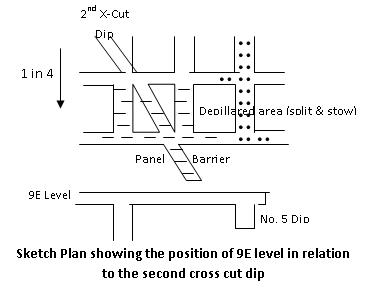You are here :
Home Silewara Colliery on 18.11.1975
|
Last Updated:: 02/06/2015
Silewara Colliery on 18.11.1975
Silewara Colliery
| Date of the Accident |
- 18.11.1975 |
| Number of persons killed |
- 10 |
| Owner |
- Western Coalfields Ltd. |
| Place |
- Dist. Nagpur (Maharastra State) |
This inrush was caused by the failure of a thin coal rib separating development workings from current water-logged workings. A small virgin patch in IV Bottom seam (dip 1 in 4) was being developed on the dip side of a depillared area (split and stow). The 9 East level, which was being developed, was close to the dip-most part of the 2nd cross-cut dip in the old workings of the depillared area. The plan showed that a coal rib of 5 m existed between the end of this dip heading and the 9th level. However, when the level advanced to a position beyond this dip gallery by 5.11.1975, copious seepage of water was noticed from the rise side of this level gallery. Further drivage of the level was therefore stopped. A dip gallery (No.5 dip) was opened out from the end of this level and the dip drivage continued for a few days when further progress was stopped due to accumulation of water. The water seepage from the rise side of the 9E level continued for all these days.
On 18.11.1975, the rib separating the 9th level from the 2nd cross-cut dip gave way creating an opening 0.9 m wide x 1.9 m high through which 6500 m3 of water from the depillared area rushed into the 9E level and flooded the dip side workings in different parts of the mine and drowned 10 workers.
Subsequent inspection of the site showed that the rib, shown as 5 m thick on the plan, was only 0.6 m thick. Due to the seepage of water through it for a period of 13 days (5th to 18th Nov.) and the vibrations caused by blasting in the nearby 5 dip, the rib became weak and failed to withstand the head of accumulated water.

The old workings were reported to have been inspected in September and found to have been free from any accumulation of water. No inspection was made after that till the date of accident. However, it appeared that the water had taken a long time to accumulate and had become stagnant as was indicated by the foul smell when it flooded the dip workings.
The management had knowledge of the water logging; yet no precautions were taken. The copious seepage of water in the level was ignored. The accident was thus caused by the gross negligence on the part of the management.